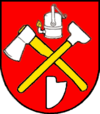Hačava
| Hačava | ||
|---|---|---|
| coat of arms | map | |

|
|
|
| Basic data | ||
| State : | Slovakia | |
| Kraj : | Košický kraj | |
| Okres : | Košice-okolie | |
| Region : | Košice | |
| Area : | 36.92 km² | |
| Residents : | 215 (Dec. 31, 2019) | |
| Population density : | 6 inhabitants per km² | |
| Height : | 660 m nm | |
| Postal code : | 044 02 | |
| Telephone code : | 055 | |
| Geographic location : | 48 ° 40 ′ N , 20 ° 50 ′ E | |
| License plate : | KS | |
| Kód obce : | 521396 | |
| structure | ||
| Community type : | local community | |
| Administration (as of November 2018) | ||
| Mayor : | Peter Gábor | |
| Address: | Obecný úrad Hačava 47 04402 Turňa nad Bodvou |
|
| Website: | www.hacava.sk | |
| Statistics information on statistics.sk | ||
Hačava (until 1927 Slovak and "Vieska"; German Wagnerhau , Hungarian Ájfalucska - to 1902 Falucska ) is a municipality in the east of Slovakia with 215 inhabitants (December 31, 2019). It is located in Okres Košice-okolie , a part of Košický kraj .
geography
The municipality of Hačava is located in the north of the Slovak Karst mountain range ( Slovenský kras ), surrounded by the national park of the same name , 31 kilometers west of Košice .
From the connecting road R2 between Košice and Rožňava , the only access road branches off at Turňa nad Bodvou via the neighboring municipality of Háj and through a narrow valley to Hačava. In winter this road can quickly become impassable. The townscape is characterized by wooden houses. Some Košice residents own weekend houses called chata here .
Neighboring municipalities to Hačava are Medzev in the northeast, Turňa nad Bodvou in the southeast, Háj in the south, Bórka in the west and Štós in the northwest.
history
The place is mentioned for the first time in 1409 and was founded by German settlers under a "Master Wagner". Due to the Turkish wars and the Polish-Lithuanian war, the residents were forced to leave the place again. It was only repopulated by Ruthenians in the 17th century. From 1918 to 1927 his official name was also Vieska .
Until 1918 the community belonged to the Kingdom of Hungary and then came to the newly formed Czechoslovakia . Through the First Vienna Arbitration she came back briefly to Hungary from 1938 to 1945 (under the name Ájfalucska ).


